When people see Simon, they immediately stop in their tracks!
Some would say that’s due to his sturdy, intimidating Pittie body that screams “excessive energy” all over, but the reason is far more obvious!
This fashionable Pittie steals hearts wherever he goes just because he looks a little different than a regular dog. Simon, ladies and gentlemen has a unique marking on his head – his majestic eyebrows that leave everyone stunned!
Meet Simon, The Star Of The Show
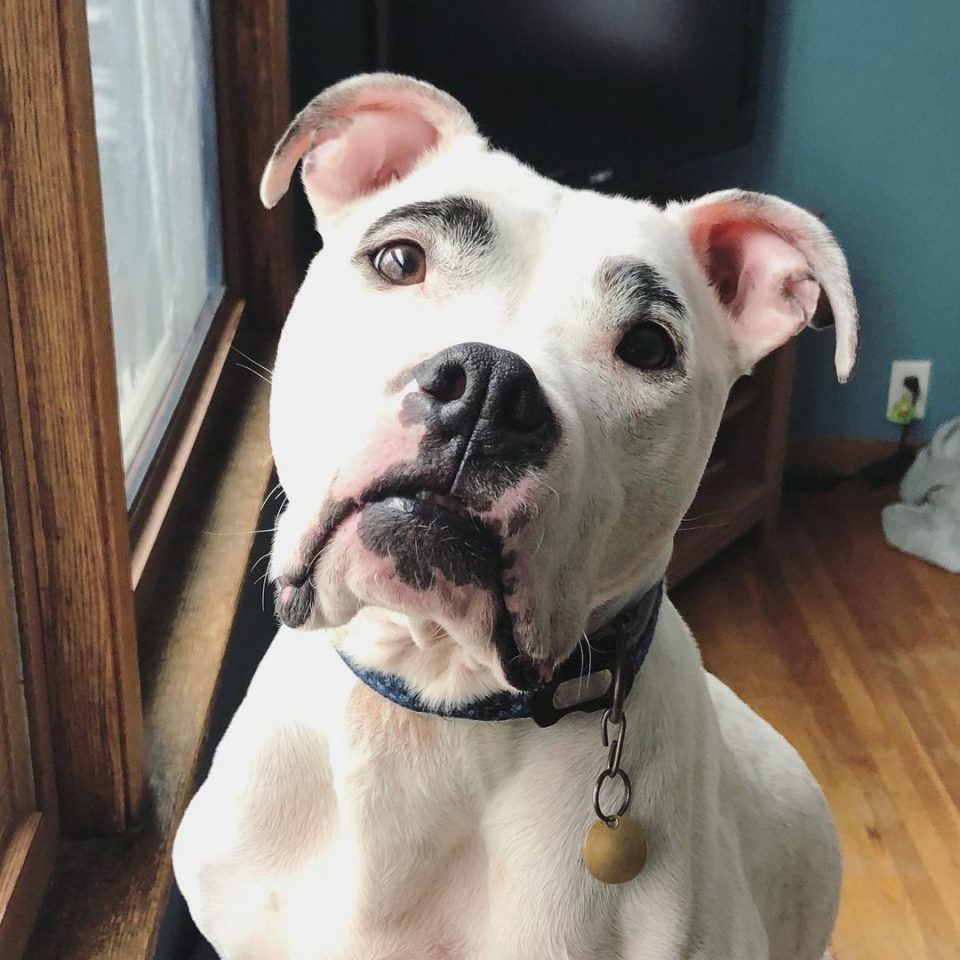
When Stephanie Williams first saw Simon, never in her wildest dreams could she imagine that he would become irreplaceable to her. With his hauntingly cute eyebrows, Simon is the absolute star of the show!
“His personality matches his eyebrows perfectly. He has a huge personality, a huge heart,” his mom told Cuddle Buddies.
He arrived at his home in Minnesota in 2012 as a foster after he was returned to the shelter by his family. But, before he even had the chance to have a home of his own, Simon had a long way to go.
Together with his littermates, Simon was saved by a Minnesota rescue after he was only minutes away from being euthanized by animal control. Then, Stephanie stepped up.
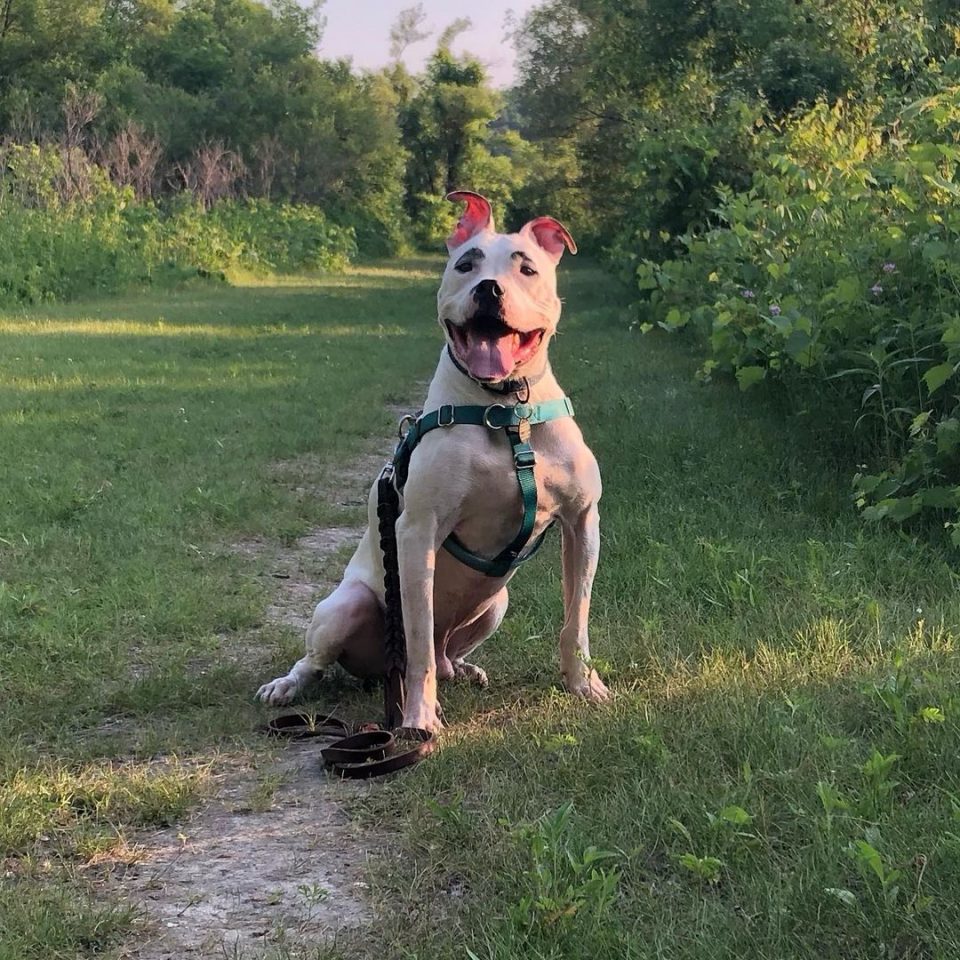
During the first couple of weeks, Simon didn’t even know how to dog. He was completely misbehaved and looked like he needed someone to show him basic manners.
That’s when Lily, Stephanie’s other dog, took things over!
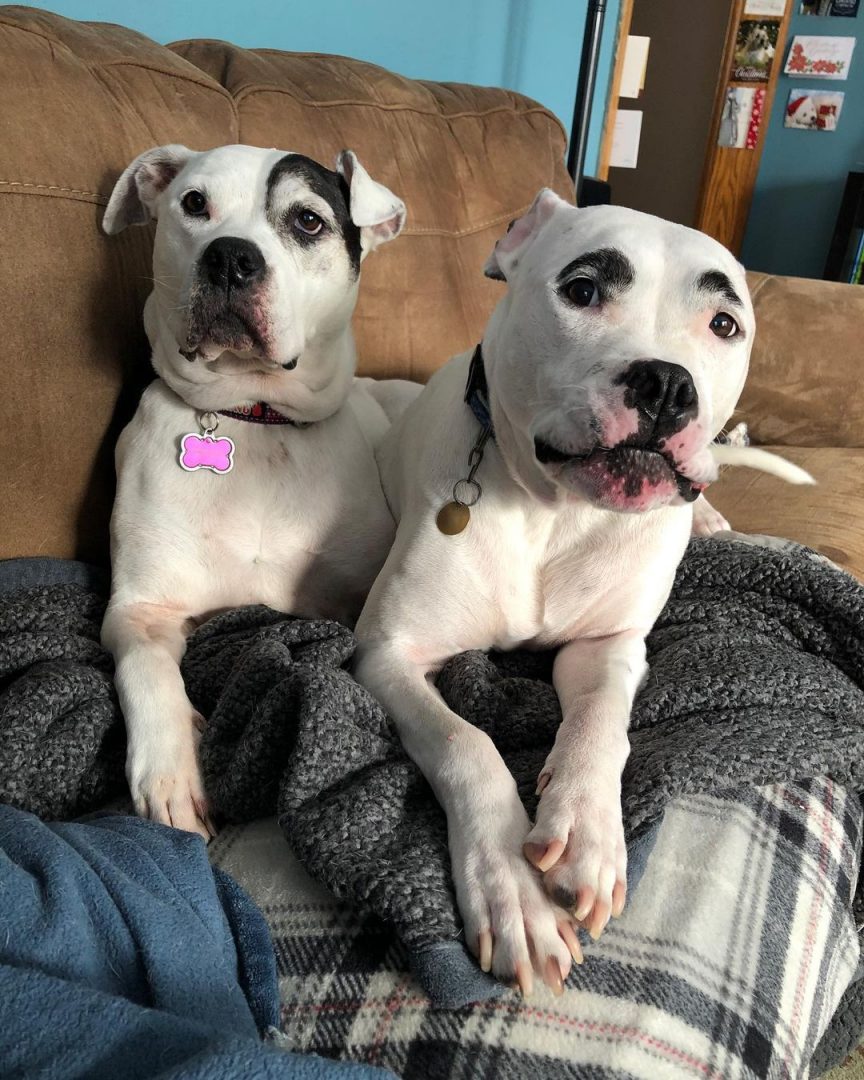
She switched to her “big sister” mode and paved the way for Simon. In no time, he picked up basic house manners and followed his sister in everything.
“The relationship that Lily and Simon had was more of a big sister-little brother. She was gonna watch out for him, protect him,” says Stephanie.
Even though Simon was a natural Mr Mischievous with so much energy at his disposal, Lily helped him a lot to adjust to the new home. And, the two became the best friends in the world!
Soon after, Stephanie decided that Simon would become a foster fail. And, their story took a more pawsitive turn!“I was sitting on the couch and he jumped up next to me. He let out his heavy sigh and rested his head on my lap, and I knew, like, that was it. I’m not gonna give up on you,” Stephanie told The Dodo.
The Pawfect Activity
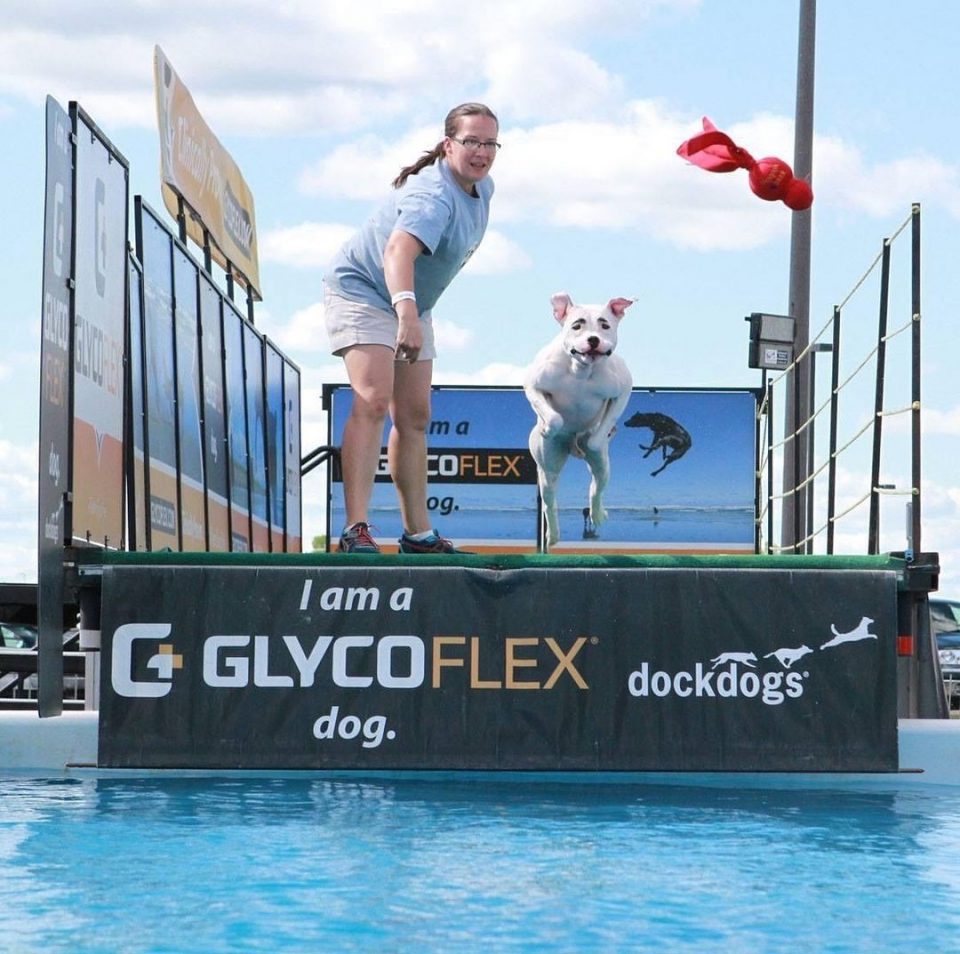
Stephanie knew that Simon was no ordinary Pittie, and his high energy needed to be addressed properly. That’s when she came up with something amazing!
One day, she took Simon to a local dock diving just to check how he would respond to this new activity – and he found his ultimate hobby in the world!
Simon was just obsessed with the pool and all that went with it. During the first couple of training sessions, he could barely be held steadily on the dock. But, after a while, Simon picked up all the tips and started competing.
In a 40-foot-long pool, Simon’s personal record is 19 feet, 6 inches.
He didn’t run, but he literally flew every time Stephanie would throw him a ball to the pool. Simon, the doggo of unique appearance and just the sweetest smile, looked so magnificent doing what he truly loved.
And, as a bonus, he’ll always come home happy and laid down, ready to shower his momma and his sister with endless cuddles.
From Healing The Wounds To A New Friendship
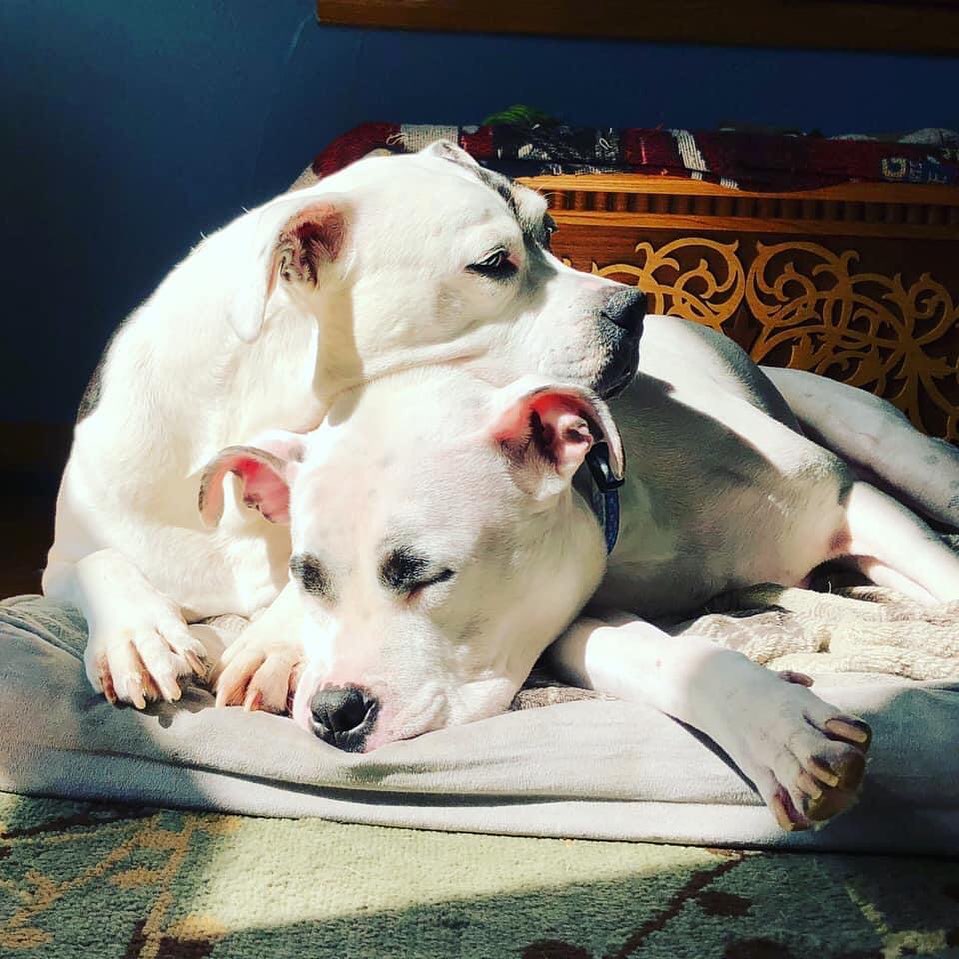
In 2020, Stephanie got the worst news possible. Her long-time companion and Simon’s best friend in the world, Lily, was diagnosed with cancer.
Despite the treatment and just the best care, she didn’t make it. Lily crossed the rainbow bridge in 2021, only nine months after the first diagnosis, leaving the whole family in tears.
Simon was heartbroken. He coped with the loss of his sister for so long until, one day, his momma decided to take the first step toward healing.
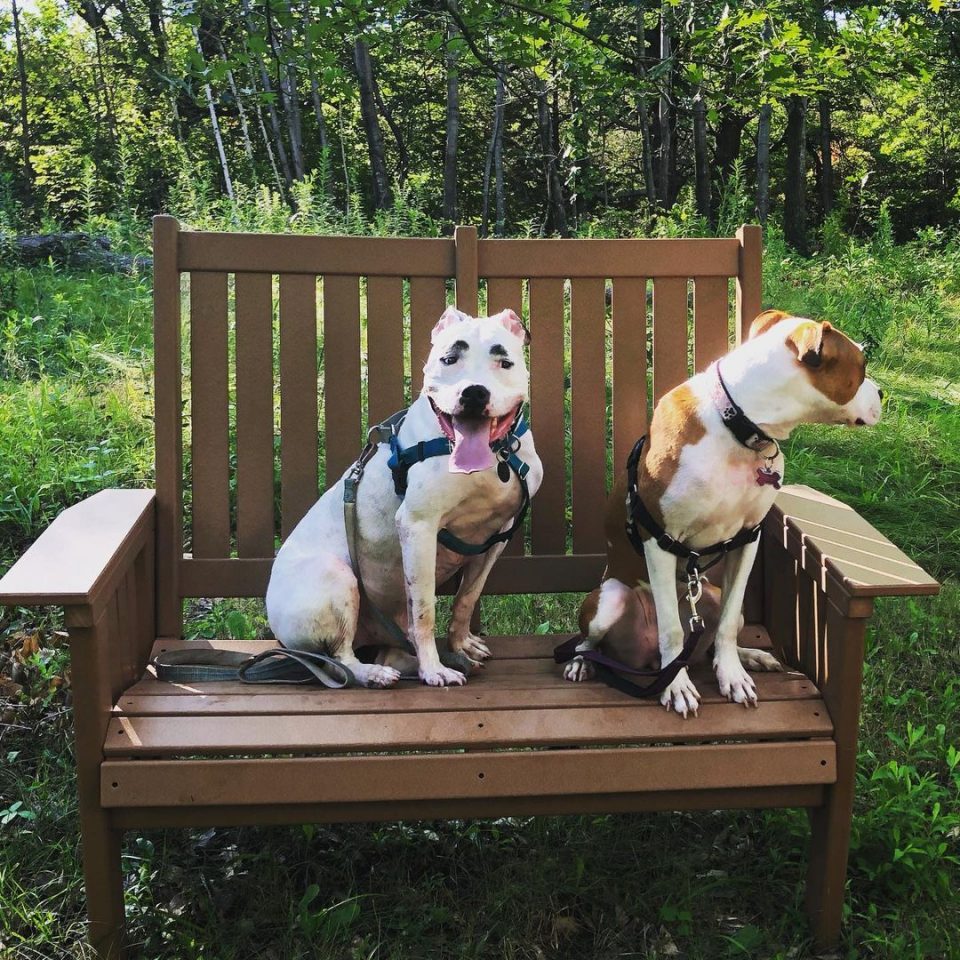
She was scrolling through social media when the picture of Mabel popped up. As soon as she saw it – she decided to give this new girl a chance, and boi was she right!
It was like a sign from Lily, saying, “Hey, little brother, now’s the time for the next challenge in your life!”
And, Simon took it like a champ!
He welcomed his new sister with paws wide open, showing her the way like Lily showed him once.
“She definitely helped to cheer Simon up. She brought out the youth in him again. And, now Simon shows the patience to Mabel that Lily showed to Simon. And they are such a pair,” says Stephanie.
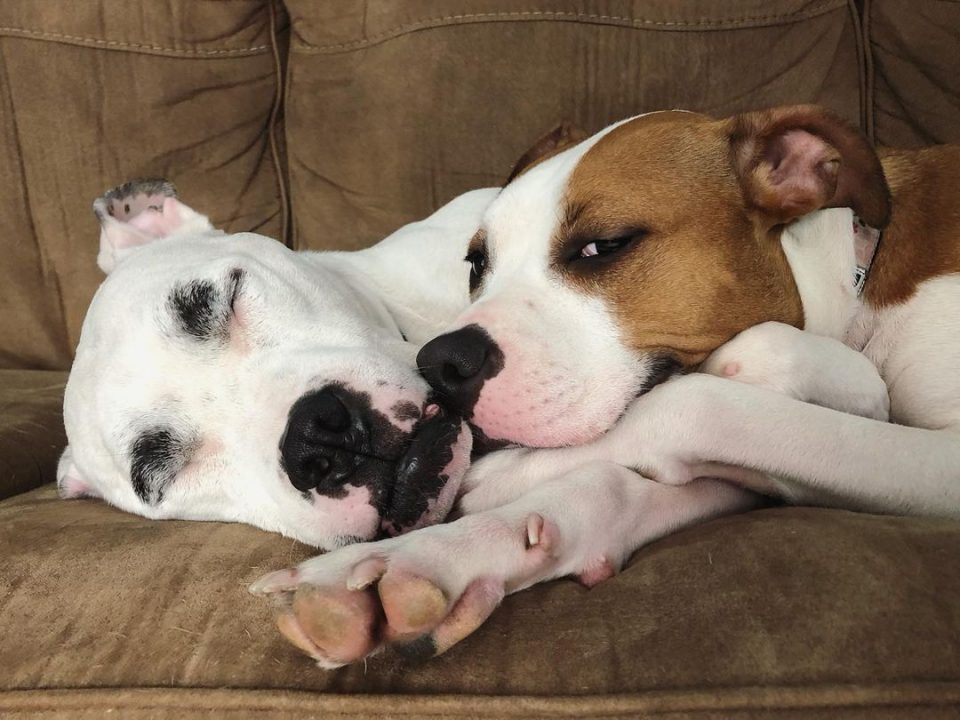
Even though Simon is in his golden years now, his new sister helped him preserve his life sparkle. Around her, he feels like a pup again, chasing new adventures and having the time of his life!
Mabel and Simon still have lots of memories to create together down the road.
And, if one thing can be stated with certainty, it’s that Simon’s fashionable eyebrows, despite his age, will never go out of style!
If you’ve ever watched your furry friend munching on grass in the backyard, you might have wondered, “Why do dogs eat grass anyway?” It’s a common sight that leaves many pet owners curious about their canine companions’ quirky behavior. Dogs, with their playful antics and sometimes puzzling habits, often keep us on our toes. Grass-eating is just one of those fascinating mysteries that make them so endearing.
For dog owners, the sight of their beloved pup grazing on the green stuff can be both amusing and perplexing. While we may never fully understand all the reasons behind this behavior, one thing’s for sure – dogs definitely have a way of keeping us entertained and on our toes with their unpredictable antics. So, next time you catch your furry friend nibbling on some grass, just remember, there’s more to it than meets the eye.
Understanding the Phenomenon: Why Do Dogs Eat Grass?
Theories Behind Grass Eating in Dogs
When it comes to why dogs eat grass, there are several theories to consider:
- Dietary Aid: Dogs might eat grass to help with digestion or to get more fiber in their diets.
- Instinctual Behavior: Some believe it’s a natural instinct inherited from their wild ancestors who consumed plant material.
- Nutritional Gaps: Your furry friend may crave something missing from their diet, prompting them to snack on grass.
- Soothing an Upset Stomach: Dogs might eat grass to induce vomiting if they have an upset stomach, acting as a natural remedy.
Differentiating Between Normal and Compulsive Behaviors
To distinguish between normal grass eating and compulsive behavior in dogs:
- Frequency: Occasional grass nibbling is common, but if your dog eats grass excessively, it could indicate an issue.
- Monitoring: Keep an eye on your pet’s behavior and visit a vet if the grass eating becomes compulsive.
- Health Check: Regular veterinary check-ups help ensure your dog’s overall health and well-being.
- Environmental Factors: Assess your dog’s environment for any stressors that could be causing the behavior.
Remember, a curious pup’s grass-eating antics can be intriguing, but understanding the reasons behind it can help you ensure your furry companion leads a healthy and happy life.
Health Implications of Dogs Eating Grass
Is Eating Grass Safe for Dogs?
Eating grass is a common behavior in dogs, and in most cases, it’s considered safe. Dogs might eat grass for various reasons like aiding digestion or relieving irritation, but it’s essential to ensure the grass is free from any chemicals or pesticides that could harm your furry friend.
When to Be Concerned About Your Dog’s Grass Eating
If your dog is eating an excessive amount of grass to the point of vomiting frequently, or if the grass consumption is accompanied by other symptoms like lethargy or loss of appetite, it might be a cause for concern. In such cases, it’s best to consult your veterinarian to rule out any underlying health issues.
Remember, while occasional grass eating is generally harmless, monitoring your dog’s behavior and seeking professional advice when needed can help ensure their well-being and happiness.
The Role of Diet in Grass Eating Behavior
Nutritional Deficiencies and Their Influence
If your dog is eating grass, it could signal a nutritional gap in their diet. Dogs may resort to eating grass to supplement missing nutrients like fiber, which aids in digestion. Ensuring your pet’s food provides a good balance of essential nutrients may help reduce their grass-munching behavior.
The Impact of a Balanced Diet on Grass Munching Habits
A well-rounded diet plays a crucial role in your dog’s grazing habits. When your furry companion is satisfied with their meals, they are less likely to seek out alternative food sources like grass. Providing high-quality dog food tailored to their nutritional needs can help diminish their urge to graze on grass.
Behavioral Aspects and Psychological Reasons
Stress, Boredom, and Attention-Seeking Behavior
Dogs may sometimes eat grass as a response to stress or boredom. Just like humans may engage in habits like nail-biting or fidgeting when anxious, dogs may exhibit similar behaviors. If you notice your furry friend munching on grass excessively during stressful situations or when they’re not mentally stimulated enough, it could be their way of coping with emotions. Providing adequate exercise, mental stimulation, and a comfortable environment can help reduce stress-related grass eating habits.
Grass Eating as an Instinctual Action
Eating grass can also be a natural instinct for dogs. In the wild, canines are known to consume plant materials as part of their diet to aid in digestion. Even though domesticated dogs have a diet primarily consisting of commercial dog food, their innate instinct to eat grass may still manifest. It’s a behavior that has been passed down from their ancestors as a means to regulate their digestive system. So, if you see your dog occasionally munching on grass, it could simply be a natural tendency inherited from their wild counterparts.
How to Manage and Redirect Grass Eating Behavior
Providing Alternatives to Grass
If you notice your dog frequently eating grass, provide safe alternatives like chew toys, interactive puzzles, or raw carrots to redirect their behavior. These options can offer mental stimulation and fulfill their natural desire to chew without ingesting potentially harmful grass.
Training Tips to Curtail Unwanted Grazing
To discourage your dog from eating grass, consider positive reinforcement training techniques. Reward desired behaviors, such as ignoring grass or turning away when offered, with treats or praise. Consistent training paired with redirection towards appropriate activities can help break the habit of excessive grass consumption.
Conclusion
So, there you have it! Dogs eating grass is a common behavior with various reasons behind it. From stress relief to aiding digestion, our furry friends have their own motivations. Remember, moderation is key, and ensuring a safe environment for them to graze is important. By providing mental stimulation, exercise, and a healthy diet, you can help address this behavior. If excessive grass eating leads to issues like vomiting, it’s best to seek advice from your vet. Redirecting their focus with chew toys or training techniques can steer them away from excessive grazing. Understanding why dogs eat grass can lead to better care and a happier, healthier pup.
Frequently Asked Questions
Why do dogs eat grass?
Dogs may eat grass due to various reasons such as aiding digestion, following an instinct inherited from wild ancestors, coping with stress or boredom, or seeking additional nutrients.
Is it safe for dogs to eat grass?
In moderation, it is generally safe for dogs to eat grass. However, it is crucial to ensure the grass is free from harmful chemicals like pesticides or fertilizers.
When should I be concerned about my dog eating grass?
If your dog exhibits symptoms like vomiting after consuming grass or displays excessive grass-eating behavior, it is advisable to seek veterinary advice promptly.
[no_toc]

Hey there, I’m Janet Brooks, a dog-loving student from California. I’m all about helping pups in need, especially those without homes. Me and my awesome friends work together to give shelter and love to stray dogs. Oh, and I also write blogs about dogs to share helpful info.